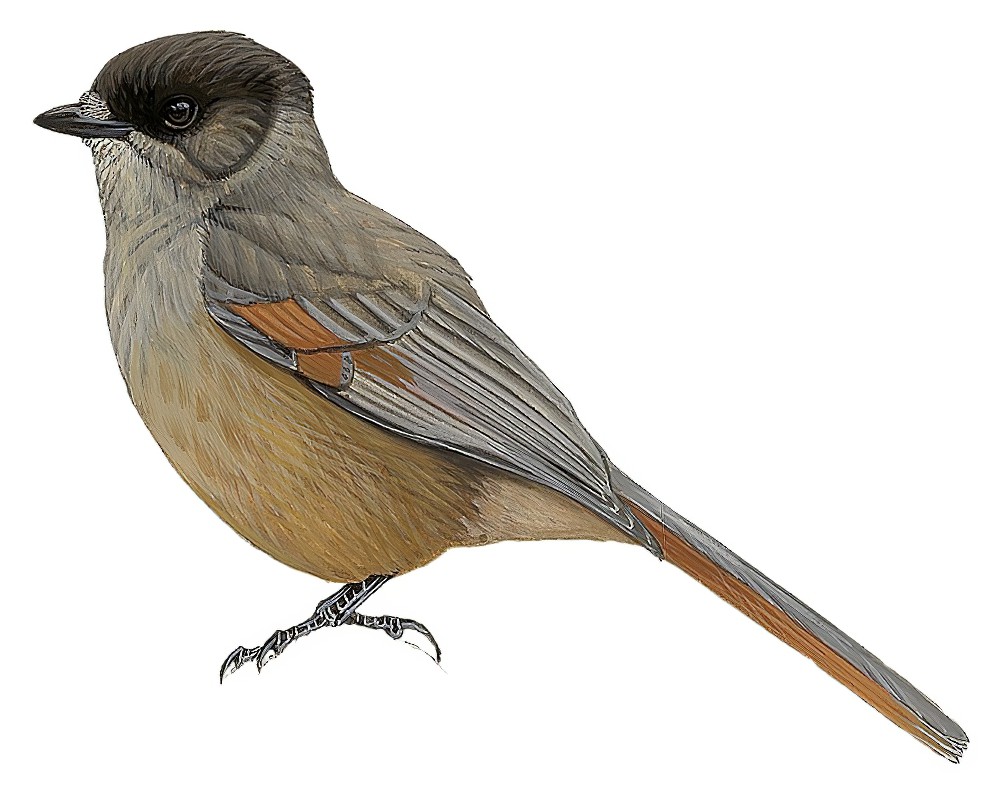Siberian Jay / Perisoreus infaustus

Siberian Jay
SCI Name:
Protonym: Corvus infaustus Syst.Nat.ed.10 p.107
Taxonomy: Passeriformes / Corvidae / Perisoreus
Taxonomy Code: sibjay1
Type Locality: Europae alpinis sylvis; restricted to Sweden by Hartert (1903, Vog. pal. Fauna, 1, p. 34).
Author: Linnaeus
Publish Year: 1758
IUCN Status: Least Concern
DEFINITIONS
PERISOREUS
(Corvidae; Ϯ Grey Jay P. canadensis) Bonaparte 1831, considered the Grey Jay and the Siberian Jay P. infaustus allied to the nutcrackers Nucifraga and analogous to the tits Parus, and the name perhaps reflects their habit of hoarding acorns and other food < Gr. περισωρευω perisōreuō to heap up, bury beneath. However, Coues 1882, suggested the derivation L. peri- very, exceedingly, and sorix, bird of augury dedicated to Saturn, the god originally placated by human sacrifice (v. infaustus), and this seems to have been reinforced by Bonaparte 1831: “Perisoreus; Nob. (*). ... (*) Credo bene d’istituire questo sottogenere affine alle Nucifraghe pel Corvus infaustus di Siberia, il C. canadensis d’America, ed una nuova specie Artico-Americana anche più aberrante (e per conséguenza atta a servir di tipo) totalmente cinerea. Questo nuovo gruppo offre una decisa analogia colle Cinciallegre (Parus).”; "Perisoreus Bonaparte, 1831, Giorn. Arcadico, 49, p. 42. Type, by subsequent designation (Gray, 1840, List Gen. Birds, p. 37), Corvus canadensis Linnaeus." (Vaurie in Peters 1962, XV, 235).
Var. Perisorius.
Synon. Boanerges, Dysornithia.
infausta / infaustus
L. infaustus unlucky, unfortunate, inauspicious < in- not; faustus favourable, auspicious < favere to favour.
• "19. — 5. C. infaustus nov. sp. Cuculis (Cacomantis) sepulcralis Gray Proc. Z. Soc. 1860. p. 359." (Cabanis & Heine 1862); in some Indomalay cultures the cries of cuckoos are regarded as the portends of doom (subsp. Cacomantis variolosus).
• "This without doubt is that bird our common people call the Night-raven, and have such a dread of, imagining it cry portends no less than their death, or the death of some of their near Relations: For it flies in the night" (Willughby 1678); "153. NYCTICORAX INFAVSTVS. THE NIGHT RAVEN." (T. Forster 1817) (syn. Nycticorax nycticorax).
• "48. CORVUS. ... infaustus. 12. C. dorso cinereo, rectricibus rufis: intermediis duabus cinereis, fascia nigricante. Turdus rectricibus rufis: duabus intermediis cinereis fascia nigricante; proximis apice cinereis. Fn. svec. 187. Merula saxatilis. Will. orn. 145. t. 36. Raj. av. 65. Alb. av. 3. p. 51. t. 55. Habitat in Europæ alpinis sylvis. Avis proterva, sæpe carnivora." (Linnaeus 1758). Formerly the Siberian Jay was considered a bird of ill omen in Norway and in many parts of Sweden, being known locally as Olycksfågel misfortune bird. However, in modern Scandinavia this jay is regarded with affection (Perisoreus).
SUBSPECIES
Siberian Jay (infaustus)
SCI Name: Perisoreus infaustus infaustus
infausta / infaustus
L. infaustus unlucky, unfortunate, inauspicious < in- not; faustus favourable, auspicious < favere to favour.
• "19. — 5. C. infaustus nov. sp. Cuculis (Cacomantis) sepulcralis Gray Proc. Z. Soc. 1860. p. 359." (Cabanis & Heine 1862); in some Indomalay cultures the cries of cuckoos are regarded as the portends of doom (subsp. Cacomantis variolosus).
• "This without doubt is that bird our common people call the Night-raven, and have such a dread of, imagining it cry portends no less than their death, or the death of some of their near Relations: For it flies in the night" (Willughby 1678); "153. NYCTICORAX INFAVSTVS. THE NIGHT RAVEN." (T. Forster 1817) (syn. Nycticorax nycticorax).
• "48. CORVUS. ... infaustus. 12. C. dorso cinereo, rectricibus rufis: intermediis duabus cinereis, fascia nigricante. Turdus rectricibus rufis: duabus intermediis cinereis fascia nigricante; proximis apice cinereis. Fn. svec. 187. Merula saxatilis. Will. orn. 145. t. 36. Raj. av. 65. Alb. av. 3. p. 51. t. 55. Habitat in Europæ alpinis sylvis. Avis proterva, sæpe carnivora." (Linnaeus 1758). Formerly the Siberian Jay was considered a bird of ill omen in Norway and in many parts of Sweden, being known locally as Olycksfågel misfortune bird. However, in modern Scandinavia this jay is regarded with affection (Perisoreus).
Siberian Jay (ostjakorum)
SCI Name: Perisoreus infaustus ostjakorum
ostjakorum
Ostyak, an all-embracing term for several Siberian peoples (Samoyeds, etc.) and their languages.
Siberian Jay (yakutensis)
SCI Name: Perisoreus infaustus yakutensis
yakutensis
Yakutia, a region of eastern Siberia inhabited by the Yakuts people.
Siberian Jay (ruthenus)
SCI Name: Perisoreus infaustus ruthenus
ruthenica / ruthenus
Med. L. Ruthenia a former name for much of Muscovy, Belarus and the Ukraine.
Siberian Jay (opicus)
SCI Name: Perisoreus infaustus opicus
opicus
L. opicus foolish, clownish, stupid, ignorant < Opici, Opicorum Oscans, a primitive people of Campania.
Siberian Jay (rogosowi)
SCI Name: Perisoreus infaustus rogosowi
rogosowi
Viktor Viktorovich Rogozof (1886-1938) Russian taxidermist, naturalist, explorer in Siberia and Mongolia (Laurent Raty in litt.) (subsp. Perisoreus infaustus).
Siberian Jay (varnak)
SCI Name: Perisoreus infaustus varnak
varnak
"The word "Varnak" is derived from the Russian initials V. R. N. K., denoting the words; "Vor, razboinyik, nakazanny knuton" (= thief, robber, punished with the knout), and with these initials the exiles [to Siberia] were formerly branded" (Stadling 1901) (Laurent Raty in litt.). The epithet 'thief' accurately describes the bold habits of the Siberian Jay (syn. Perisoreus infaustus tkachenkoi).
Siberian Jay (sakhalinensis)
SCI Name: Perisoreus infaustus sakhalinensis
sakhalina / sakhalinense / sakhalinensis
Sakhalin I., Far Eastern Russia, North Pacific Ocean.
Siberian Jay (maritimus)
SCI Name: Perisoreus infaustus maritimus
maritima / maritimus
L. maritimus maritime, of the sea < mare, maris sea.
● "Of this bird I can find no description. It inhabits the low, rush-covered islands along our Atlantic coast, where I first found it" (A. Wilson 1811) (Ammodramus).
UPPERCASE: current genus
Uppercase first letter: generic synonym
● and ● See: generic homonyms
lowercase: species and subspecies
●: early names, variants, mispellings
‡: extinct
†: type species
Gr.: ancient Greek
L.: Latin
<: derived from
syn: synonym of
/: separates historical and modern geographic names
ex: based on
TL: type locality
OD: original diagnosis (genus) or original description (species)












